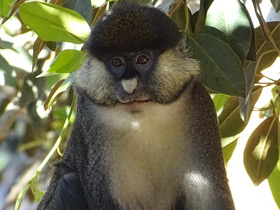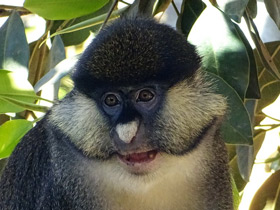The red-tailed monkey (Cercopithecus ascanius), the black-cheeked white-nosed monkey, red-tailed guenon, redtail monkey, or Schmidt's guenon
Red-tailed monkey видео
The red-tailed monkey (Cercopithecus ascanius), also known as the black-cheeked white-nosed monkey, red-tailed guenon, redtail monkey, or Schmidt's guenon, is a species of primate in the family Cercopithecidae.
It is found in Angola, Cameroon, Central African Republic, Democratic Republic of the Congo, Kenya, Rwanda, South Sudan, Tanzania, Uganda, Zambia, and possibly Burundi. The red-tailed monkey is usually black, red, or orange. Although native to this region, it has spread north and south as well as it can survive in different habitats and under different conditions. It is a distinct creature in its habitats and is gradually becoming endangered due to deforestation and over-exploitation through hunting and predation.
It inhabits a wide variety of habitats: lowland rainforests, gallery forests and coastal swamps, arid acacia forests, as well as mountain forests.
Appearance
Distinguishing features of adult Cercopithecus ascanius schmidti: black face, bluish skin around the eyes, a light spot on the nose and white fur on the cheeks. Depending on the subspecies, the colour of the nose varies from white or yellow to almost black. The English name "red-tailed monkey" is related to the colour of the primate's fur, which varies from reddish to brownish at the tail end, with the fur colour being lighter underneath. Cercopithecus ascanius schmidti is characterised by sexual dimorphism: males reach an average weight of 4-6 kg, females only 2.9 kg; the body length of males ranges from 40-60 cm, females 32-38 cm. Tail length: 62-89 cm in males and 53-78 cm in females.
Lifestyle and social behaviour
Cercopithecus ascanius schmidti are diurnal arboreal primates, very agile and active. Their main activity hours are early morning and late afternoon. A group of monkeys walks approximately 1.4 km per day in search of food. Cercopithecus ascanius schmidti live in groups of 7 to 35 animals, usually including one male and several females. The best average group size is 11-14 individuals. The size of the territory occupied by a group is about 120 ha, which they defend from invasion by outsiders. In areas with abundant food, several groups of monkeys may gather together, also in large trees they may stay together during rest periods.
As in all primates, communication in this species is complex and includes chemical or olfactory, visual and tactile components. Visual communication plays an important role in the life and social structure of these apes. Visual components make up the communication system in the form of eyebrow raising, facial skin tension and bouncing. These signals are often used to alert potential predators or unwanted impostors.
Thus, staring is used as a threat signal. The eyes are directed towards a stimulus (e.g. another individual), the eyebrows are raised with the scalp drawn back, the facial skin is also stretched and the ears are moved slightly backwards. At the same time, the spots under the eyes, coloured differently from the rest of the face, contrast sharply with the surrounding complexion.
Another posture expressing threat is a fixed stare with the mouth open but teeth covered, while the animal itself may bounce up and down slightly.
The vocal communication of the species is represented by chirps, which serve to communicate between group members. This form of communication is mainly used as a social factor between the members of each group of monkeys. Of the vocal communication signals, trills are the best known. These sound signals are usually made by young animals when approaching an adult. The trill sounds softly, the sound vibrates and gradually fades and lowers in pitch. The functional purpose of this call is to demonstrate complete submission and obedience. Cercopithecus ascanius schmidti greet and identify each other with a special greeting in which two animals approach each other and then touch noses. Tactile communication in the form of nose-to-nose greeting often precedes play or mutual grooming and is an example of dynamic greeting.
Cercopithecus ascanius schmidti are often found in close association with other primate species, such as red colobus and mangabeys and colobus. Colobus are able to bite through the hard outer shell of the fruit and then Cercopithecus ascanius schmidti can eat the remains of the fruit, which contain a normally inaccessible pulp. Cercopithecus ascanius schmidti are mainly frugivorous, but constantly supplement their diet with young shoots of plants, flowers, buds, gum secretions and insects. Cercopithecus ascanius schmidti have cheek pouches for food storage, allowing them to keep their hands free while on the move.
Reproduction
Cercopithecus ascanius schmidti tend to breed throughout the year, although the peak breeding season is from November to February and the birth of young is from April to November. The species is characterised by polygyny, with one male mating with all females in the group. Normally, a female in oestrus demonstrates her receptivity and willingness to mate by a demonstrative behaviour known as "performance".
Gestation lasts an average of 6 months, after which a single calf is born. Newborn calves usually weigh about 400 g, have light grey fur and are permanently attached to the mother, with their four limbs firmly clinging to the fur on her belly, which carries, protects and feeds them. The young are constantly carried by the female for the first few weeks of life.
Other single females of the same social group also try to take care of the calf and sometimes conflicts arise between them because of this.
The female's rank in the group often has a decisive influence on the social status of her mature daughters, who remain in the group after reaching puberty. Males, upon reaching sexual maturity, will withdraw from the group, forming a separate troupe and attempting to replace dominant males in female groups over time.
When the dominant male is eliminated, the new leader will attempt to kill all existing offspring in the group, thus stimulating lactating females to enter the oestrus period and give birth to their own offspring earlier. Males usually reach sexual maturity at six years of age; females participate in breeding from four to five years of age.
Feeding habits
Red-tailed monkeys are primarily fructivorous, but are considered omnivorous because they will eat leaves, flowers, or insects in times where fruit is scarce. As they forage, these monkeys gather their findings in the expandable cheeks of their mouths. The pouches will hold a large amount of food where they can forage in one area and then carry their food away to another location where it is safe to consume without the threat of another stealing from them.
Threats to existence
Cercopithecus ascanius schmidti periodically raids orchards, plantations with crops of maize, banana, millet, beans, pumpkin, pineapple, causing significant crop damage. In areas of low productivity, this has become a serious problem for bordering human settlements. It is not surprising that farmers regard the monkeys as pests and destroy them wherever they see them.
Natural enemies of Cercopithecus ascanius schmidti are large birds of prey, wild cats (especially leopard) and sometimes prey to chimpanzees or large snakes. Although there is no precise data on the lifespan of the species in the wild, it is known that they can live up to 22 years in captivity, other researchers have claimed that they can live up to 30 years. Obviously, life expectancy in the wild is somewhat shorter.
Although the fate of Cercopithecus ascanius schmidti is not of concern at present, its future status is of concern due to the threat of habitat loss, especially from deforestation.

















































